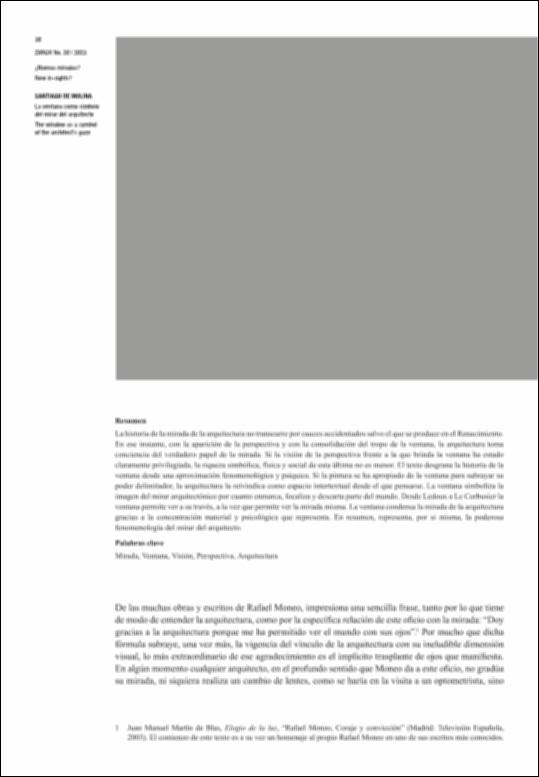Por favor, use este identificador para citar o enlazar este ítem:
http://hdl.handle.net/10637/16475La ventana como símbolo del mirar del arquitecto
| Título : | La ventana como símbolo del mirar del arquitecto The window as a symbol of the architect’s gaze |
| Autor : | Molina Rodríguez, Santiago de |
| Materias: | Mirada; Arquitectura; Architecture |
| Editorial : | Universidad de Zaragoza |
| Citación : | de Molina, Santiago. 2023. «La Ventana Como símbolo Del Mirar Del Arquitecto». ZARCH, n.º 20 (junio):30-47 |
| Resumen : | La historia de la mirada de la arquitectura no transcurre por cauces accidentados salvo el que se produce en el Renacimiento. En ese instante, con la aparición de la perspectiva y con la consolidación del tropo de la ventana, la arquitectura toma conciencia del verdadero papel de la mirada. Si la visión de la perspectiva frente a la que brinda la ventana ha estado claramente privilegiada, la riqueza simbólica, física y social de esta última no es menor. El texto desgrana la historia de la ventana desde una aproximación fenomenológica y psíquica. Si la pintura se ha apropiado de la ventana para subrayar su poder delimitador, la arquitectura la reivindica como espacio intertextual desde el que pensarse. La ventana simboliza la imagen del mirar arquitectónico por cuanto enmarca, focaliza y descarta parte del mundo. Desde Ledoux a Le Corbusier la ventana permite ver a su través, a la vez que permite ver la mirada misma. La ventana condensa la mirada de la arquitectura gracias a la concentración material y psicológica que representa. En resumen, representa, por si misma, la poderosa fenomenología del mirar del arquitecto. The history of the architectural gaze follows a linear course, except for the one that occurs in the Renaissance. At that moment, with the appearance of perspective and the consolidation of the window trope, architecture became aware of the true role of the gaze. From a historical point of view, the vision of perspective has been privileged over the window way of seeing the world. But the symbolic, physical, and social richness of the window is meaningful. The text unravels the history of the window from a phenomenological and psychic approach. If the painting has appropriated the window to emphasize its delimiting power, architecture claims it as an intertextual space from which to think itself. The window symbolizes the image of the architectural gaze insofar as it frames, focuses and discards part of the world. From ancient times, to Ledoux and Le Corbusier, the window allows us to see through it, at the same time as it allows us to see the gaze itself. The window condenses the architectural gaze thanks to the material and psychological image it represents. In short, it shows, by itself, the powerful phenomenology of the architect’s gaze |
| URI : | http://hdl.handle.net/10637/16475 |
| Derechos: | http://creativecommons.org/licenses/by-nc-nd/4.0/deed.es OpenAccess |
| ISSN : | 2387-0346 |
| Fecha de publicación : | 23-jun-2023 |
| Centro : | Universidad San Pablo-CEU |
| Aparece en las colecciones: | Escuela de Politécnica Superior |
Los ítems de DSpace están protegidos por copyright, con todos los derechos reservados, a menos que se indique lo contrario.


